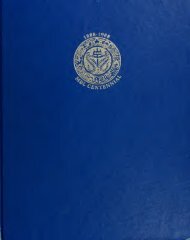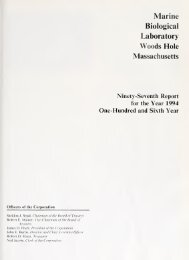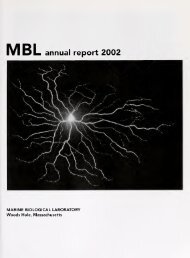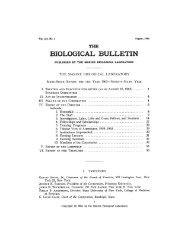18 researchgenomes. The National Aeronautic and Space Administration supports the Josephine Bay Paul Center’smembership in the astrobiology community, while the Department of Energy continues to supportour bioinformatics initiative that focuses on annotation and evolution of gene families in the metalreducingmicrobe Shewanella oneidensis.Continuing support from the G. Unger Vetlesen Foundation underpins growth and stability of thecenter, and the Alfred P. Sloan Foundation is supporting an International Census of Marine Microbes(ICoMM) project, which seeks to organize the international community in its effort to understandthe diversity and role of microbes throughout the world’s oceans. This is a collaborative project thatengages investigators from around the world and is managed jointly by the Josephine Bay Paul Centerand the Royal Netherlands Institute for Sea Research – NIOZ.Educational activities are also integral to the Josephine Bay Paul Center. In addition to hosting graduatestudents and participating in the Brown-MBL Graduate Program, center scientists are involved in theMBL’s Parasitology and Microbial Diversity courses as well as the renowned Workshop on MolecularEvolution. Mitchell Sogin also co-directs, with Claire Fraser of The Institute for Genomic Research, acourse titled “Advances In Genome Technology and Bioinformatics.” Center scientists also reach out toK-12 and undergraduate educators, offering two microbiology-based workshops for teachers annually.“Good Cholesterol” Provides Humanswith Immunity to Certain Parasites:Now We Know WhyFor years biomedical researchers have known that highdensity lipoproteins, commonly called HDLs or “goodcholesterol,” are responsible for protecting humans fromcertain parasites, but couldn’t explain how. Now scientistsfrom the MBL’s Bay Paul Center have discovered thathuman HDLs work their bug-repelling magic by serving asa platform for the assembly and delivery of two naturallyoccurring proteins that combine to create a super-toxicantimicrobial.The research, published in the September 30, 2005, issueof the Journal of Biological Chemistry, focuses specifically onhuman innate immunity to Trypanosoma brucei brucei, theparasite that gives African cattle the deadly disease calledNagana, but which doesn’t harm humans even thoughscientists believe they are exposed to it. The parasite isa close relative of Trypanosoma brucei gambienese andTrypanosoma brucei rhodesiense, the organisms that causedeadly African sleeping sickness in humans.The findings that two proteins work synergistically to killthe Nagana parasite in humans contradict a long-heldhypothesis that a single protein was the key to HDL’sparasite-fighting power. “The research may be helpful toveterinarians hoping to develop treatments to aid Africancattle farmers, who lose three million cattle and around abillion U.S. dollars annually to Nagana,” says April Shiflett,a fifth-year graduate student in the Brown-MBL GraduateProgram in Biological and Environmental Sciences and anauthor on the paper. Scientists also hope the research willprovide key information to investigators seeking treatmentsfor other parasitic infections, such as malaria.To identify the proteins—known as apolipoprotein L-1 (apoL-1) and haptoglobin-related protein (Hpr)—MBL scientiststested different amounts and combinations of the proteinson Trypanosoma brucei brucei specimens. To survive, theparasite needs to digest the lipids in HDLs. Because HDLcarries these proteins and enables them to combine, it isnature’s perfect delivery system for the antimicrobial. Andwhen test organisms digested the super-toxic protein mix,the single-celled organisms literally dissolved.Shiflett and her colleagues in the MBL’s Global InfectiousDiseases Program are focused on understanding themolecular workings of a variety of parasites, including thosethat cause human African sleeping sickness, Nagana, andmalaria. Such research is crucial to finding better treatments,and possibly cures, for diseases that are ravaging the peopleand economies of places like Africa and other developingcountries.Funding for this study was provided by the NationalInstitutes of Health.
Bay Paul Center staff, continuedresearch 19Melissa LerchJessica Mark WelchElizabeth McClimentShanta MesserliTorsten OchsenreiterNRC POSTDOCTORAL SCIENTISTJulie HuberBIOINFORMATICS TAXONOMISTAdorian ArdeleanSENIOR RESEARCH ASSISTANTSRudo KieftPhillip NealRESEARCH ASSISTANT IIIKatherine HammarSusan HuseRESEARCH ASSISTANT IIDilrukshi EkanayakeLeslie GrahamAbby LaatschAdam LazarusBruce LudersRESEARCH ASSISTANT IMatthew BeverlySarah BiberShanda BirkelandMichael CiprianoCourtney DiPaoloSara FaulknerSeth N. KauppinenMichelle MarshallWilliam MorganJennifer RoccaCatherine SweeneySusanna TherouxDaniela WilmotPUBLIC OUTREACH COORDINATORSMichele Bahr, AstrobiologySarah Rae Bordenstein, BPCMicrobiologyPART-TIME RESEARCH ASSISTANTMindy RichlenTECHNICAL ASSISTANTMorgan MandigoMBL SUMMER FELLOWSMiguel Navarro, Instituto deParasitología y Biomedicina, SpainAnton Post, Hebrew <strong>University</strong>, IsraelDavid Rand, Brown <strong>University</strong>GID VISITING SCHOLARSLaura Cliffe, <strong>University</strong> of Manchester,United KingdomKatelyn Fenn, <strong>University</strong> of Edinburgh,ScotlandElijah Kem Guthui, National Museumsof Kenya, NairobiSergio Rubin-de-Celis, UniversidadeFederale de Sao Paulo, BrazilMary Beth Saffo, Harvard <strong>University</strong>Jean Claude Tedom, <strong>University</strong> ofYaounde, CameroonGID VISITING SCIENTISTSCassie Conley, NASALaura Cotlin, <strong>University</strong> of AlabamaMichael LaMontagne, McNeese<strong>University</strong>ADMINISTRATIVE STAFFRichard Fox, Sr. Research Assistant,System AdministrationPatricia Halpin, Staff CoordinatorJonathan Neff, Sr. Research Assistant,System AdministrationTara Nihill, Center AdministratorKatherine Newhall, Staff AssistantBertil Olsson, Sr. Research Assistant,ComputationGRADUATE STUDENTSJae Hur, Harvard <strong>University</strong>Lorin Jakubek, Brown <strong>University</strong>-MBLGraduate StudentErica Lasek-Nesselquist, Brown<strong>University</strong>-MBL Graduate StudentApril Shiflett, Brown <strong>University</strong>-MBLGraduate StudentJustin Widener, Brown <strong>University</strong>-MBLGraduate StudentSTUDENT HELPERPolina BulyginaHIGH SCHOOL STUDENTKevin Lin, Falmouth High School ScienceProject Mentoring ProgramSUMMER/TEMPORARY STAFFAlexandra Papa, <strong>University</strong> ofMassachusetts, AmherstJeremiah Bernier, Oregon <strong>State</strong> <strong>University</strong>Talia Bigelow, Hampshire CollegeMegan Cohen, Brown <strong>University</strong>Pia Hugus, <strong>University</strong> of ConnecticutGeorge Waksman, MassachusettsInstitute of TechnologyArielle Glatman Zaretsky, Brown<strong>University</strong>SUMMER HIGH SCHOOL HELPERSJohn BatterMerry BatterCaroline PierceChristopher Sylvia
- Page 1 and 2: MBL7 MBL StreetNon-profit Org.U.S.
- Page 5: contents1 report of the director an
- Page 8 and 9: 2 report of the director and ceoTha
- Page 10 and 11: 4 program profiles“Our lives are
- Page 12 and 13: 6 program profilesoffering unmatche
- Page 14 and 15: 8 program profilestraining pre and
- Page 16 and 17: 10 program profilesforging powerful
- Page 18 and 19: 12 program profilesengaging undergr
- Page 20 and 21: 14 program profilesexciting k-12 te
- Page 22 and 23: 16 researchresearchThe MBL is one o
- Page 26 and 27: 20 researchPublicationsAmaral Zettl
- Page 28 and 29: 22 researchThe High Cost of Coastal
- Page 30 and 31: 24 researchJohn Hobbie Named MBL Di
- Page 32 and 33: 26 researchwhitman centerThe Whitma
- Page 34 and 35: 28 researchA New Twist on Power Wal
- Page 36 and 37: 30 researchfellowshipsMBL Research
- Page 38 and 39: 32 researchAlbert and Ellen Grass F
- Page 40 and 41: 34 researchFriday Evening Lecture S
- Page 42 and 43: 36 researcharchitectural dynamics i
- Page 44 and 45: 38 researchBUMP staff, cont.PH.D. S
- Page 46 and 47: 40 researchmarine resources program
- Page 48 and 49: 42 researchMarine Resources Program
- Page 50 and 51: 44 researchprogram in molecular phy
- Page 52 and 53: 46 researchlaboratory of aquatic bi
- Page 54 and 55: 48 researchlaboratory of norman wai
- Page 56 and 57: 50 educationsummer coursesBiology o
- Page 58 and 59: 52 educationGreenberg, Everett, Uni
- Page 60 and 61: 54 educationMaul, Kristen, City Col
- Page 62 and 63: 56 educationPata, Veena, National I
- Page 64 and 65: 58 educationspecial topics coursesA
- Page 66 and 67: 60 educationMaiato, Helder, Institu
- Page 68 and 69: 62 educationBrower, Stewart, Univer
- Page 70 and 71: 64 educationFACULTYCurran, Sean, Ma
- Page 72 and 73: 66 educationGeunes-Boyer, Scarlett,
- Page 74 and 75:
68 educationSTUDENTSAparicio, Paul,
- Page 76 and 77:
70 educationother educational progr
- Page 78 and 79:
72 educationscholarship awardsIn 20
- Page 80 and 81:
74 educationCaswell Grave Scholarsh
- Page 82 and 83:
76 educationMilton L. Shifman Endow
- Page 84 and 85:
78 mblwhoi librarytrends, and curre
- Page 86 and 87:
80 financialsfinancialsreport of th
- Page 88 and 89:
82 financialsOperating History and
- Page 90 and 91:
84 giftsWe are grateful as well to
- Page 92 and 93:
86 giftsRestricted gifts(up to $9,9
- Page 94 and 95:
88 giftsMEMBER($1,000 - $2,499)Edwa
- Page 96 and 97:
90 giftsJohn E. Hobbie Fund for Sci
- Page 98 and 99:
92 giftsMr. and Mrs. J. Sterling Cr
- Page 100 and 101:
94 giftsLectureshipsJohn J. Cebra L
- Page 102 and 103:
96 gifts10th AnniversaryDr. Eva M.
- Page 104 and 105:
98 giftsMBL AssociatesThe Associate
- Page 106 and 107:
100 giftsMr. James K. TaylorMrs. Al
- Page 108 and 109:
102 giftsMBL Golf OutingIn July, MB
- Page 110 and 111:
104 giftsFellowships Established in
- Page 112 and 113:
106 giftsSemester in Environmental
- Page 114 and 115:
108 governance & administrationgove
- Page 116 and 117:
110 governance & administrationcorp
- Page 118 and 119:
112 governance & administrationDr.
- Page 120 and 121:
114 governance & administrationcoun
- Page 122 and 123:
116 governance & administrationadmi
- Page 124:
118 governance & administrationPhot
















